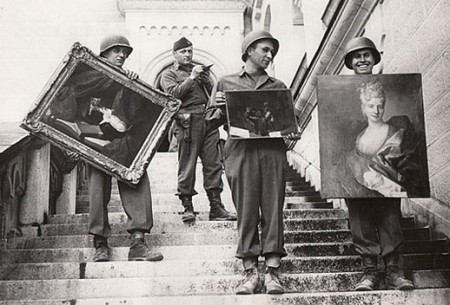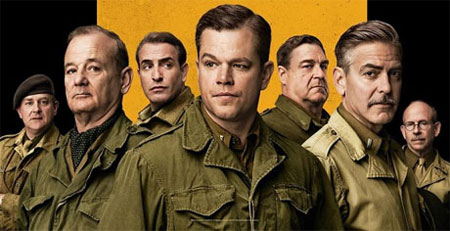Before the Winter Freeze of 2014, when the lights when out and the phone and Internet service crashed, Linda and I went to see the movieThe Monuments Men.
It’s a movie based on a real situation when during WW II President Franklin Delano Roosevelt, a good democrat and apparently lover of art, dispatched a group of middle-aged men – art historians, museum curators, architects, and other arty types to go to Europe and save the art the Nazis were stealing and perhaps would destroy at the end of the war – as they were loosing. As it turns out – they also saved it from the Russians who would claim it as their spoils of war.
Critics had panned the movie, but I’ve learned not to listen to them and after the movie was over I knew why. There were no special effects, limited explosions, no car chases, and get this – no sex scenes. What kind of movie can that be? Well, there was an offer of sex.
What George Clooney, the movie’s director, presented us was a slightly Hollywood juiced up movie of historical facts, with an all-star cast. The basics were that the Americas would save the art from the Nazis, who looted five million works of art, and returned what they could to the original owners. And as usual, our good allies the French didn’t trust us to do the right thing.

American GIs, under the supervision of Capt. James Rorimer, carry paintings down the steps of Neuschwanstein Castle in southern Germany, where about 21,000 items stolen by the Nazis from French art collectors were recovered.
What was hard to believe in the Clooney movie was that seven arty types would do all this without the help of any regular Army types. In reading about the real events, from 200 to 350 men and women worked on this project – including our allies. I would think a letter from the President would get you more help than a jeep driver who spoke German. But Hollywood can’t help being Hollywood.
I won’t say much more about the movie, except it was much better than critics stated, but Clooney could have told more of the story.
The movie turns out to be quite timely as last year German authorities found 1,400 pieces of stolen art from WW II in a Munich apartment, including works by Matisse and Picasso. And recently an 18th-century painting from that group was returned to Poland, nearly 70 years after it was stolen by the Nazis.
There is an older movie about this same subject called The Train (1964), which was directed by John Frankenheimer and staring a very physical Burt Lancaster – playing a railroad official who stopped a train full of stolen art headed to Germany. It’s a great black and white film.
